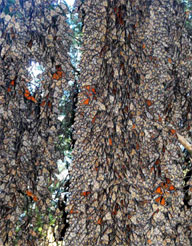Right now, 56.5 million monarch butterflies are at their winter home in Mexico, a slightly higher number than last year’s lowest-ever count of 34 million.
Nine colonies of monarchs are covering trees on 2.79 acres, up from just 1.65 acres last year, according to World Wildlife Fund-Mexico and the Mexican government.
"The population increase is welcome news, but the monarch must reach a much larger population size to be able to bounce back from ups and downs," from severe weather, pesticides, climate change, disease and predation, says Tierra Curry, a researcher with the Center for Biological Diversity, which petitioned for protection under the Endangered Species Act along with Center for Food Safety, Xerces Society and other organizations.

In the mid-1990s, there were 1 billion monarchs. During that decade, monarchs never covered less than 13 acres in Mexico and hit a high of 44.95 acres in 1993. But over the last decade since GMO agriculture was introduced, monarchs have been suffering dramatic declines.
Scientists expected more monarchs this year because of near-perfect weather conditions during their breeding season, but they hoped for a bigger rebound.
"Despite this small increase, monarch populations are still severely jeopardized by milkweed loss in their summer breeding grounds due to increasing herbicide use on genetically-engineered crops," explains George Kimbrell, senior attorney for Center for Food Safety.
Widespread planting of GMO crops in the Midwest – where most monarchs are born – is largely driving the decline. Most GMO crops are sprayed with Monsanto’s Roundup herbicide, a potent milkweed killer – the only plant monarchs lay their eggs on and which can feed its larvae. Spraying has virtually wiped out milkweed plants in Midwest corn and soybean fields, depriving monarchs of more than 165 million acres of habitat – nearly a third of their summer breeding grounds. Monarchs need a "road" of milkweed from Canada down through the east and central US to Mexico.
Milkweed (Asclepias) is a tough plant that traditionally blanketed the Midwest. Even turning much of the land to farming over the last couple hundred years didn’t impede the Monarch, because milkweed (and other wildflowers) still grew along edges and even between rows of crops. The plants are gorgeous and easy to grow even in dry conditions.
Asclepias syriaca (Common Milkweed) on left
Asclepias tuberosa (Butterfly Weed) on right


"It is crucial that we restore and protect the habitat of this iconic species in all three countries, but above all that we limit the use of herbicide and land conversion in the US and maintain efforts to avoid deforestation in Mexico," says Omar Vidal, Director General of WWF-Mexico.
Planting Milkweed Across the US
People have responded by planting milkweed across the US and Canada, but it’s crucial they buy the correct species and from retailers that don’t sell them pre-treated with neonic pesticides – which aren’t labeled. You can locate the right seeds and plants through Xerces Society and Monarch Watch.
"We’ve got to get people to plant milkweed all over. We’re not going to save this species unless the public gets involved. Saving the monarch butterfly has to become a national priority," Orley Taylor, executive director of Monarch Watch told the Denver Post.
This is the kind of project that gets results. Milkweed is being planted on fallow farm fields, in parks, under power lines, on federal land, along roads and at senior centers and schools, says Taylor. A major effort is underway for farmers to bring back large-scale pollinator habitats.
Learn about projects to bring monarchs back:
